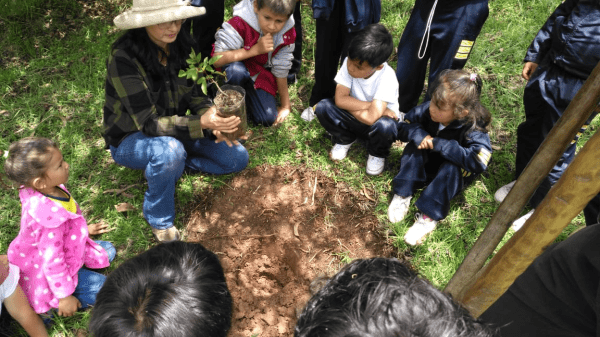Head in the Cloud (Forest), Boots on the Ground

Guest blog by Shea Wickelson and Natalia Laverde
Shea is a schoolteacher from Utah who recently finished a Fulbright research trip studying environmental education in Colombia. Natalia is a Colombian conservationist and educator who founded La Illusion Nature Reserve near Bogota.

More than two centuries ago, the German naturalist Alexander von Humboldt travelled to Colombia and found himself dumbfounded by the biodiversity of the region. His writings and illustrations—inspired by the Latin American world—established the foundation for the modern science of ecology. When I (also an outsider) embarked on my own trip researching environmental education in Colombia, I sought out some of the same ecosystems he celebrated. From cloud forests to coral reefs to high Andean paramos, ecological splendor wasn’t hard to find. But a focus on only the “natural” ecosystem—without the humans who rely on it and who have so heavily shaped it—doesn’t seem “natural” at all. A myopic focus on the landscape can become disconnected from historic and cultural beauty, not to mention the social justice inequities which are intimately wrapped up with control of land—which is why the work of La Illusion Nature Reserve and its founder, Natalia Laverde, seems especially important to share.
Shea: When you started La Illusion, you really tried to learn a lot about the local community. Can you explain how you did that?
Natalia: My grandparents were farmers, and land was very important to them. I was raised in the city, but I felt like I was living in two worlds: the urban and the rural. My grandfather said that everyone needs a square foot of land so that you have a place to die. There was one time, soon after my husband and I bought La Illusion, that I brought my grandma. I wanted to show her the land, but it was raining hard, and the roads were really bad. So we went by foot, and we were so wet, and the clay of the road was almost up to your knees. We called a neighbor, Don Alberto, and he brought a mule, and my grandma and I both rode the mule back to the car. I felt like I had this moment of connection: cultural, ancestral, historic. I started to get to know Don Alberto after that; he was one of the first people I met. I started to research and interview everyone I could find around La Illusion.
S: What kind of questions did you ask?
N: I love seeing how people here view their environment. So I would often ask them to draw. You could see these interesting differences, like how kids would draw the nearby snow peak mountains. The kids from more urban backgrounds always drew the mountains green with a white peak. The local kids always draw it blue, and blue is the color that it really looks! I asked adults to draw maps (cartographia social) of how they saw their land. The maps were an epiphany. The maps drawn by the local people were circles, and they always drew the neighbors’ houses and labeled who lived there: “Here’s Don Sergio’s house, here’s Don Alberto’s…” Even though there were fences, they never drew fences in their maps. People who were from the city but who had bought land out in the same area (including my husband and I!) always drew squares, with fences, sometimes powerlines.

S: Ah! That’s so interesting. It makes me think of how when we stayed on a farm in Antioquia, Colombia for a couple weeks, my family and I had to walk through three other farms just to get to the farm where we were staying. We kept thinking we had arrived at the correct farm, but nope, the neighbors just waved us on, or, in one case, offered us coffee. These communal trails, there’s a special word for it here in Colombia, isn’t there?
N: Servidumbre. They are trails built by consensus, and people respect that. And because people from the rural areas spend so much time walking, you could really see it in their maps that they really knew the area better. Whereas the people who had come from the city were in cars; they have a different perspective.
S: I went to one site, a rainforest reserve in the mountains run by a large NGO with a significant amount of funding from outside of the country. This reserve was very focused on preserving and restoring the ecosystem, but they had sort of shut out the local community—they’d put up fences that cut off the servidumbre, and they had much more of a private property sort of ethic. They have tensions with neighbors as a result. Though few locals visit the reserve, international ecotourists do. Ecotourists have become an audience for their environmental education programs, and by appealing to wealthier visitors the NGO raises money to buy more land.

N: Greengrabbing.
S: Haha. That’s a new term for me. It feels like the goal of environmental education at your reserve, La Illusion, is not about “greengrabbing” and is more about environmental empowerment.
N: We don’t want to be environmental colonizers: those who impose ideas of restoration or conservation without taking into account the local perception and culture. Inhabitants in this area are traditionally farmers, so their knowledge and identity are about agriculture. Here, the ownership of land is very much related to economic and political power. To be part of the community council (Junta de Acción Comunal) you have to own land. There are plenty of people who were born in this area and are part of the community, but who do not have land. For example, our friend and coworker, Marco, who helped us reconstruct La Ilusión. His grandfather and father taught him everything about the resources you will find in the cloud forest: timber, medicinal plants, poisonous plants, types of soils and crops. He was born in the area, is 68 now, is single, and he has no land. His family sold the inherited properties many years ago and migrated to the city. Marco ended up working on other farms or renting land. This year the weather has caused problems, and his cattle are not growing enough, so by the time he pays rent for the pasture, he will not be making a profit. Many of the small-scale agricultural farmers are exploited. We offered for him to bring his cows here to the reserve, but he is too proud to do it without paying rent. I think he is learning that cattle might not be the best right now.
S: Yes. That’s tough, and it’s such a part of the culture that it’s not like you can just flip a switch and change it. But you’ve been focusing on young people as well; tell us more about some of your goals there.
N: The young people in the community are looking for opportunities. It’s one of our goals to help young people start their own projects. As Marco left the reserve in search of independence and retirement, we reviewed the profile of his job and aligned it to the goals and principles of the Foundation El Bosque y La Niebla, the organization we created in 2019. We know the power of rural women here—we have been witnesses to their hard work and struggles. So we decided to open the position of administrator of the reserve to a young local woman. Elizabeth was the best candidate, and she is living and working at the reserve now: she’s brilliant, has a lot of initiatives, and is very excited. She is in love with bees, and right now bees are key for our needs; for improving the forest. Some local people say, “She is a woman! She is too young!” But we know she is what we want. We have learned a lot from her, and she has learned a lot from us.

S: You are truly an example of education as a two-way street. But tell me more about the way you are teaching. Because you are a wonderful anthropologist, but you are also an educator and trying to make changes: you want people to take care of the land, you’ve planted thousands of trees, you’re working with people to build living fences as ecological corridors, and you’re connecting kids with the forest ecosystem through games and hikes.
N: Thank you for calling me an educator! I feel honored. I think the examples and the facts are some of the best teachers. In 2007 our land was quite deforested, and we’ve worked to bring back the cloud forest through both spontaneous restoration and planting. So far, we’ve planted around eight thousand native trees. In 2015 there was a drought, and so many of the other farms were lacking water, but the streams and ponds in the restored areas were still full. A lot of people noticed—even Doña Lilia, an old lady who lives near here who always says no to everything and is always mad. We invited our neighbors to plant trees, and we invited her. She came but was really quiet, and she said to me, “Here Doña Natalia, I brought you this borrachero (Brugmansia) plant so you can remember me.” And it was really sweet.

S: I love that story. As a schoolteacher I always tell people that 50% of my job (maybe more!) is building relationships. It’s when we build trust that learning and transformation can happen. I love the mix of activities that you have going on at La Illusion, which include an interpretive center about cultural history, involvement of scientists interested in both green agriculture and forest restoration, visits by school children to connect them with the forest, and your forest therapy tours.
N: What we want is to educate, to reconcile urban and rural people with the cloud forest. We want people to connect with their own history, but also to connect more with conservation and sustainable production. I don’t want people just to come to La Illusion and see the forest and the vision and then just say “Ciao.” I want people to change. So when I think about my vision for the future, it is to move hearts.
